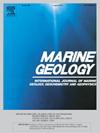14C dating of tsunami deposits in arid environments: How challenging can it be? The example of La Graciosa, Canary Islands
IF 2.2
3区 地球科学
Q2 GEOSCIENCES, MULTIDISCIPLINARY
引用次数: 0
Abstract
14C dating of tsunami deposits in arid environments is often challenging, especially when there is no organic material available. The marine bioclasts found in the tsunami deposits thus become the main dating possibility. Apart from the reservoir effect, the main source of uncertainty is the age difference between the shells and the tsunami that transported them. Taking as an example a tsunami deposit on the island of La Graciosa (Canary Islands), we demonstrate that the marine shells (Patella) come from different sources, with 14C ages ranging from >45 kBP to 200 BP, the main source being an ancient marine terrace probably of MIS5e age. In addition, we propose a landslide source for this tsunami, the scar of which can be observed on the Famara cliff to the northeast of Lanzarote, just opposite the tsunami deposit outcrops at La Graciosa. In addition to the methodological aspects of shell dating, this study also serves as a reminder that local tsunamis generated by coastal cliff collapses are not a hazard to be neglected.
干旱环境中海啸沉积物的14C测年:有多大的挑战性?以加那利群岛的格拉西奥萨为例
干旱环境中海啸沉积物的14C测年通常具有挑战性,特别是在没有有机物质可用的情况下。在海啸沉积物中发现的海洋生物碎屑因此成为主要的测年可能性。除了水库效应,不确定性的主要来源是贝壳和运送它们的海啸之间的年龄差异。以加那利群岛La Graciosa岛的海啸沉积为例,分析了海贝壳(Patella)的不同来源,其14C年龄在45 ~ 200 BP之间,主要来源可能是MIS5e时代的古海相阶地。此外,我们提出了这次海啸的滑坡来源,在兰萨罗特岛东北部的Famara悬崖上可以观察到它的疤痕,就在La Graciosa海啸沉积物露头的对面。除了贝壳年代测定的方法方面,这项研究还提醒人们,由沿海悬崖崩塌引起的局部海啸不是一个不容忽视的危险。
本文章由计算机程序翻译,如有差异,请以英文原文为准。
求助全文
约1分钟内获得全文
求助全文
来源期刊

Marine Geology
地学-地球科学综合
CiteScore
6.10
自引率
6.90%
发文量
175
审稿时长
21.9 weeks
期刊介绍:
Marine Geology is the premier international journal on marine geological processes in the broadest sense. We seek papers that are comprehensive, interdisciplinary and synthetic that will be lasting contributions to the field. Although most papers are based on regional studies, they must demonstrate new findings of international significance. We accept papers on subjects as diverse as seafloor hydrothermal systems, beach dynamics, early diagenesis, microbiological studies in sediments, palaeoclimate studies and geophysical studies of the seabed. We encourage papers that address emerging new fields, for example the influence of anthropogenic processes on coastal/marine geology and coastal/marine geoarchaeology. We insist that the papers are concerned with the marine realm and that they deal with geology: with rocks, sediments, and physical and chemical processes affecting them. Papers should address scientific hypotheses: highly descriptive data compilations or papers that deal only with marine management and risk assessment should be submitted to other journals. Papers on laboratory or modelling studies must demonstrate direct relevance to marine processes or deposits. The primary criteria for acceptance of papers is that the science is of high quality, novel, significant, and of broad international interest.
 求助内容:
求助内容: 应助结果提醒方式:
应助结果提醒方式:


